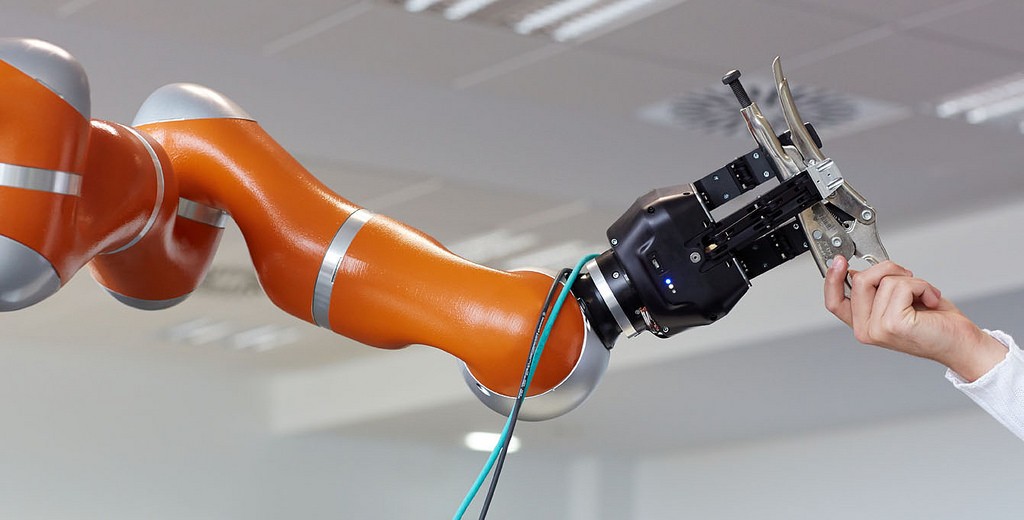Safety Is a Priority When Designing Collaborative Robots

Safety is paramount when it comes to the addition of collaborative robots, or cobots, in the workplace. From testing new designs and technologies to doubling-down on employee safety training, learning to live and work alongside robots is the new norm. Part of the challenge involves making older industrial guidelines and standards relevant to robotics-heavy workplaces. Here's a look at how companies everywhere are exploring the exciting potential of cobots while remaining mindful of employee safety.
Emerging Standards Provide Cobot Design Guidance
In February of 2016, the International Organization for Standardization released a new version of ISO/TS 15066. It revised an existing standard of the same name and built on a related standard known as ISO 10218. ISO made these changes specifically to address the rising popularity of cobots in modern workplaces and to get ahead of emerging safety concerns. This is a major plank in the paradigm shift we call Industry 4.0.
ISO/TS 15066 addresses several major safety-related components required to successfully deploy cobots alongside human workers:
- Safety monitored stops when an imminent collision is detected
- Separation monitoring, or the creation of a buffer zone between human and machine
- Limits to power and force in the event of a human-cobot collision
- Hand-guidance, where humans can position a robotic implement freely.
Ford Motor Co. provides a good case study about why this new set of standards comes at a good time. Earlier classes of collaborative robots assisted only in low-impact, lightweight assembly. Newer generations of cobots stand ready to help in more demanding applications — including automotive. Ford recently announced active testing of assembly line cobots in facilities in Michigan and Germany.
This can be demanding and detail-oriented work, and the case for cobots practically makes itself. How can companies like Ford keep workers safe as they share personal space with autonomous machines?
How Cobots Keep Human Counterparts Safe
In the case of Ford's automobile assembly plant in Cologne, the answer comes in the form of sensors. Ford and KUKA Roboter — a robotics manufacturer based in Germany — teamed up to test 3-foot-high cobots on assembly lines dedicated to installing shock absorbers in cars. Previously, the task required workers to operate cumbersome lifting tools to position shock absorbers and affix them properly.
Now, KUKA's diminutive cobots do the heavy lifting instead, near human assembly workers. Consequently, workers enjoy greater freedom of movement and unfettered access to air-powered tools and other implements. Each cobot maintains an awareness of its surroundings thanks to sensors, which halt the robot's action when they detect human appendages or other obstructions in their path.
Altogether, the technology in these cobots took two years to develop. Ford also solicited feedback from 1,000 workers in their production facilities. It's a great example of how cobots make modern workplaces safer for human workers. However, it also drives home how important safety-minded design is for these new classes of robots.
Robotics Engineers Answer the Call for Better Safety Standards
The case for safer cobot technology reached mainstream news outlets a few years ago. In 2015, a cobot crushed a Volkswagen assembly plant employee to death in Baunatal, Germany. Investigators determined the worker had erroneously entered the operational area of the robot.
It's little wonder Ford and KUKA Roboter ended up investing in awareness technologies in their own robotics deployments. In the case of the VW plant in Baunatal, safety measures consisted of fenced-off safety zones to keep employees away from cobots.

What happens when neither demarcated safety zones nor sensors aboard cobots are enough to prevent injury?
Of the four points of interest outlined in ISO/TS 15066, limiting the power and force of cobots is perhaps the most challenging. ISO built this new standard not just on a foundation of technology, but also on a more thorough understanding of impact points and pain thresholds in human beings. It is imperative, in any environment where robots and humans may come into contact with one another, that cobots stand equipped to reduce their speed or application of force. This is the second line of defense should sensors fail to anticipate and prevent a human-machine collision.
ISO 10218 is one of the older paradigms informing ISO's modern approach to cobot safety in the workplace. It involves equipping cobots to perform safety-rated monitored stops any time they detect a potential detection. Think of it as the creation of a safety buffer between humans and robots.
The 2016 revision to ISO/TS 15066 became necessary, in part, because cobots are making their way into a wider variety of environments. This means more, and closer, interactions between human workers and robotic ones. In areas where cobots work near humans, like Ford's shock absorber installation plants, preventing collisions isn't enough. Cobots must also be equipped to lessen the blow and mitigate the damage.
How Industrial Designers Alter the Work Environment for Human-Robot Harmony
Placing additional and more advanced technologies within cobots isn't the only approach to take. Designers of industrial facilities now rely on technologies like laser-based scanners, pressure-sensitive floor mats and robotic welding to increase production and arbitrate spaces shared by humans and robots. Better arbitrating these collaborative facilities should greatly reduce the likelihood of incidents like the one in Baunatal.
For manufacturers of automobiles, pharmaceuticals and other products, the endgame is fully autonomous robots working in harmony with humans. It's a dream that combines the intuition of humans with the robustness and reliability of machines. ISO/TS 15066 and the standards that informed it, like ISO 10218, also plot a number of intermediate steps and a variety of interpretations of the word "collaborative."
Hand-guided operation is one such interim step. This is where a robotic appendage or other implement maintains a "float state" so it may be positioned manually. Once in place, the cobot keeps its position and gripping strength. It's less a robot and more a robot-inspired appendage.
Designs like these are a big boost for safety and productivity. While not fully autonomous, they still provide an attractive blend of augmented strength, precision of movement and, when necessary, the ability to hold heavy loads for extended periods. It's another in a long series of steps intended to bring Industry 4.0 to companies everywhere, and of all sizes.
Photo Credit: LWR Robot, Technalia, Flickr
Thanks for helping to keep our community civil!
This post is an advertisement, or vandalism. It is not useful or relevant to the current topic.
You flagged this as spam. Undo flag.Flag Post


